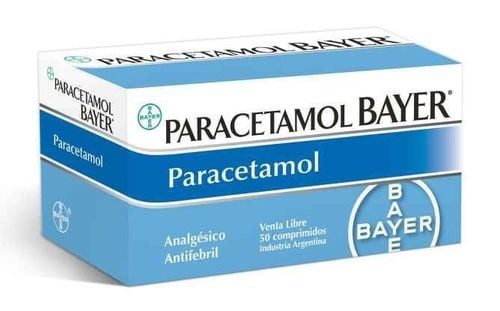This is an automatically translated article.
There are three main types of pain relievers namely non-steroidal anti-inflammatory drugs (NSAIDS), paracetamol and opioids. Each type works in a different way. Most people only need to take pain relievers for a few days or at most a few weeks, but some people need to take them for a long time depending on the cause of the pain and the number of times depending on the type of pain reliever that works. in how long.
1. What are pain relievers?
Pain relievers are drugs used to treat pain. On the market there are a large number of pain relievers with many different brands and different dosage forms such as liquid, tablets, capsules, injections, rectally with suppositories or some medicines. pain relief presented in the form of creams, ointments or patches for topical use.
Although there are a large number of pain relievers, there are only three main types (each working in a different way, with different uses), including:
Non-steroidal anti-inflammatory drugs (NSAIDS): for example such as ibuprofen, diclofenac and naproxen. Aspirin is also an NSAID; however, it is mainly prescribed in low doses to help keep the blood from clotting – for example, for people who have had a heart attack in the past, as often as once a day.
Paracetamol: this is the most commonly used pain reliever, with a duration of 4 to 6 hours, can be used 3 to 4 times a day and the maximum dose can be 4 grams / day. However, in patients with liver damage it is contraindicated.
Weak opioids and strong opioids: examples of weak opioids include codeine and dihydrocodeine. Although often described as 'weak opioids', they are still extremely effective pain relievers commonly used to treat severe pain; however, they can be significantly addictive and have side effects, so they should not be taken lightly. Examples of strong opioids include morphine, oxycodone, pethidine, and tramadol. Many people need strong opioids often during hospital inpatient treatment, after surgery.
Different pain relievers are sometimes combined into a combination pain reliever - for example, paracetamol plus codeine (co-codamol).

Thuốc giảm đau là loại thuốc được sử dụng để điều trị cơn đau
2. How to prescribe pain medication?
The type of pain reliever and the dose your doctor will prescribe depends on:
The source of the patient's pain Any other co-existing health problems How severe the pain is Effects Possible side effects of the drug The duration of action of the drug is suitable for the time of day pain usually occurs. Accordingly, paracetamol is usually prescribed first if the pain is not too severe and the patient does not have inflammation and swelling. or edema. In addition, NSAIDs are often prescribed for people with pain and inflammation - for example, if a patient has pain in the joints (arthritis) or muscles (back pain), this is because there is a potential for some symptoms. inflammation and NSAIDs work effectively to treat pain as well as inflammation. However, NSAIDs also have some possible side effects and are not suitable for everyone. For example, the drug is not suitable for people who have or are suffering from stomach ulcers. In this case, your doctor may prescribe a safer medicine such as paracetamol, although it may not be as effective. If an NSAID is needed, it can still be used at the minimum dose and number of times a day, in combination with pain relief with heat and ice for joint, muscle or ligament injuries.
Finally, weak opioids are often prescribed for more severe pain or if paracetamol and/or ibuprofen have been tried but they have not worked. Stronger opioids are often used to treat severe pain - for example, pain related to cancer, pain after surgery, or if there's a serious injury.
The rest are topical forms of pain relievers such as anti-inflammatory drugs used in the form of creams used mainly to treat pain in soft tissues and muscles, limiting unwanted effects if not used. systemic use.
3. How to comply with pain medication?
People who are in constant pain are often advised to take regular pain relievers. For example, if the person has been prescribed paracetamol, they will usually take it four times a day, every day until the pain goes away. Otherwise, they just need to take painkillers when needed.
If the patient is taking an NSAID such as ibuprofen or diclofenac, it will need to be taken with or after the main meal of the day, once or twice daily. This helps to reduce irritation, inflammation of the stomach lining and sometimes bleeding in the stomach.

Những người luôn bị đau thường được khuyến cáo dùng thuốc giảm đau thường xuyên
4. How long is the usual pain reliever treatment?
Like all medications, pain relievers should be taken for the shortest possible time, at the lowest dose to control pain. This is to help avoid any side effects.
Most people only need pain relievers for a few days (eg, for a toothache) or a few weeks (after pulling a muscle). However, some people have a painful condition and need to take pain medication for a long time. Examples include people with rheumatoid arthritis, osteoarthritis or chronic back pain.
In a nutshell, pain is an unpleasant feeling that affects different people in different ways. There are many types of pain relievers with different mechanisms of action that help control pain so that the patient feels more comfortable. However, how to use the drug depends on the pharmacokinetics, pharmacology of each drug, both helping to achieve the best effect for pain control.
Any questions that need to be answered by a specialist doctor as well as customers wishing to examine and treat at Vinmec International General Hospital, please register for an online examination on the Website for the best service.
Please dial HOTLINE for more information or register for an appointment HERE. Download MyVinmec app to make appointments faster and to manage your bookings easily.
References: health.harvard.edu, healthline.com, patient.info












